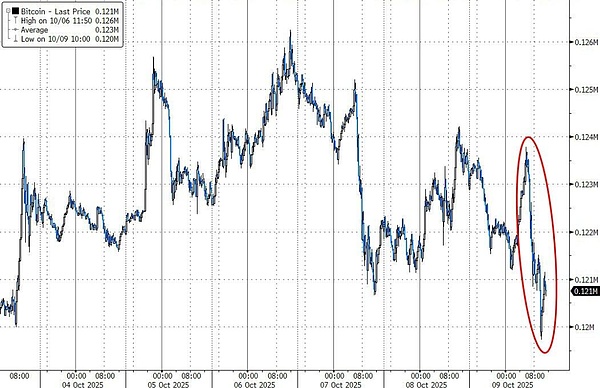Recent research shows that the threat of a "51% attack" facing Bitcoin has been severely underestimated by the market, and an attacker would only need approximately $6 billion to destroy Bitcoin. On October 9th, Duke University finance professor Campbell Harvey warned in a new study that although both Bitcoin and gold are considered favorites for "currency devaluation trades," Bitcoin faces far greater risks than gold. An attacker could take control of the Bitcoin network within a week by purchasing $4.6 billion worth of hardware, investing $1.34 billion in data center construction, and adding approximately $130 million in weekly electricity costs.

(Bitcoin's rebound failed overnight, falling about 3.3% from its intraday high)
By shorting Bitcoin in the derivatives market, the attacker can make huge profits when the Bitcoin price plummets, enough to cover the cost of the attack. Harvey emphasized:
You can destroy the value of Bitcoin with $6 billion. Although this attack sounds overly technical, it is highly credible.
Matt Prusak, president of US Bitcoin, believes that such concerns are exaggerated.Accumulating and deploying mining equipment takes years, and short selling requires huge collateral. Exchanges may also suspend suspicious transactions.
51% attack: A fundamental threat to Bitcoin
A 51% attack refers to a situation where a single party controls more than half of the computing power of a blockchain network. If successful, an attacker could tamper with the ledger, forge transactions, or even conduct a "double-spend attack"—where the same digital token is used repeatedly. In contrast, gold does not present similar systemic risks. Furthermore, the current boom in the Bitcoin derivatives market provides economic incentives for a 51% attack. Harvey's paper suggests that traders could establish short positions and generate substantial profits with less than 10% of average daily trading volume, sufficient to cover the costs of an attack. This profit mechanism makes the attack significantly more economically viable, especially considering that the cost of an attack is only 0.26% of the total value of the Bitcoin network, far lower than many investors expected. Harvey emphasized that the low cost of the attack is a serious problem for the future viability and security of Bitcoin. Harvey further pointed out that such attacks are likely to be carried out overseas, as many regions lack effective market manipulation protections.
The industry is divided on the risk of attacks
Despite Harvey's serious warnings, there are different views in the industry.
Prusak believes that the economic feasibility is not enough to support the 51% attack theory. He pointed out:
Accumulating and deploying enough mining equipment will take years, which is not feasible in reality.
Prusak also emphasized that shorting Bitcoin requires significant collateral, and that exchanges could halt trading if they suspect manipulation, preventing attackers from realizing their gains.
Other blockchains have indeed survived 51% attacks before.
Bitcoin forks Bitcoin Gold and Ethereum Classic, which have both been attacked, are smaller blockchains with less miner support and are more susceptible to manipulation.
Extended Reading:
Bitcoin, the "digital gold" of the 21st century?
Against the backdrop of dollar inflation and huge U.S. national debt, the narrative of Bitcoin as a potential hedging tool is gaining more mainstream recognition.
According to information released by MicroStrategy on the social platform X on Tuesday, as Bitcoin hit a record high of $126,080 on Monday, the value of the company's 640,031 bitcoins once exceeded $80 billion.
This figure brings the size of its corporate coffers close to those of Amazon, Google, and Microsoft, which each hold approximately $95 billion to $97 billion in cash or equivalents. This milestone comes as corporate adoption of Bitcoin explodes in 2025. Today, the number of public companies holding Bitcoin on their balance sheets has grown from fewer than 100 at the beginning of the year to over 200. Behind the growing corporate interest in Bitcoin lies a deeper motivation: hedging against macroeconomic risks. Last week, JPMorgan analysts argued that, with the US national debt nearing $38 trillion, Bitcoin, like gold, is a "depreciation trade" and can serve as a hedge against dollar inflation. This view was echoed by BlackRock CEO Larry Fink, a former Bitcoin critic who said in January that Bitcoin could reach $700,000 due to concerns about currency debasement. Furthermore, as the trend toward de-dollarization accelerates and demand for safe-haven assets surges, traditional central bank reserve allocations could also undergo a major shift. On October 10, according to a new report from Deutsche Bank, Bitcoin and gold are expected to become important components of the reserves of many central banks around the world by 2030, driven by growing interest from institutional investors and the weakening dominance of the US dollar. The report states that central banks' allocation of Bitcoin may reflect a new, modern "cornerstone of financial security," comparable to the role played by gold in the 20th century. The report believes that uncertainty and geopolitical risks caused by US tariff policies are prompting investors to seek tools to hedge against inflation and prepare for a future in which the role of traditional fiat currencies may be weakened. Against this backdrop, gold prices have broken through $4,000 per ounce, while Bitcoin is trading near the all-time high reached earlier this week. The report shows that the US dollar's share of global reserves has fallen from 60% in 2000 to 41% in 2025. This shift has not only boosted gold but also benefited Bitcoin, driving record net inflows of $5 billion and $4.7 billion into gold and Bitcoin ETFs, respectively, in June. However, Deutsche Bank senior economist Marion Laboure explicitly stated in the report that "neither Bitcoin nor gold will completely replace the US dollar." The report emphasizes that in the central bank's reserve strategy, digital assets should be regarded as a "complementary" tool to the national currency, rather than a substitute.
 JinseFinance
JinseFinance
 JinseFinance
JinseFinance Edmund
Edmund Alex
Alex Coindesk
Coindesk Beincrypto
Beincrypto Others
Others Bitcoinist
Bitcoinist Bitcoinist
Bitcoinist 链向资讯
链向资讯 Cointelegraph
Cointelegraph